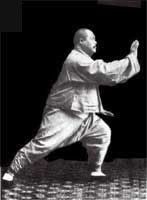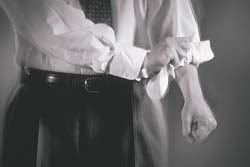 I've had a change of heart. The Carradine DVD got me turned on to the idea of doing tai chi again (see previous post), and it was cool trying out some of the moves his sifu teaches. I even learned some nice warm-ups and stretches I never knew before.
I've had a change of heart. The Carradine DVD got me turned on to the idea of doing tai chi again (see previous post), and it was cool trying out some of the moves his sifu teaches. I even learned some nice warm-ups and stretches I never knew before.But...
My years of being a dedicated martial arts student, although over a decade ago now, left an indelible imprint on me. As I tried to practice the form every morning, I kept coming up with more and more questions. "How do I get from this posture to that posture? Is that accompanied by an in-breath or an out-breath? Which way is the left foot pointed at that moment. How are the hands held when you do that motion." So, on the weekends I would pop the DVD into the computer and study what the sifu does as well as I could. And I got frustrated. Not enough clarity. I had an approximate idea of how it's done, but not close enough.
I kept looking at video clips on the internet of Chen style tai chi sets. Beautiful. Smooth. Stunning explosive strikes (fa jing) that erupt out of slow deliberate motions. I got some pointers, but... still not enough.
And I realized there were some things about Chen style that I just couldn't understand because they seemed to contradict what I'd learned in Yang Style.
And I realized there were some things about Chen style that I just couldn't understand because they seemed to contradict what I'd learned in Yang Style.
Then one day I stumbled onto this video. And I was immediately drawn to this man. (First of all I love the Australian accent, since I had a close "mate" from Australia for several years. But that's beside the point.)
His name is Erle Montaigue, and once I looked into his background, it turns out he's a martial artist's martial artist. Mr. Montaigue is a proponent of teaching tai chi as a serious (and potentially deadly) martial art, as opposed to tai chi-as-new-agey-fitness workout. Now I have the greatest respect for Arnold Tayam. What he does on Carradine's DVDs shows that he is a serious martial artist, but once I started watching Montaigue, I realized that this was the genuine article, and the Carradine material was designed to tap a certain market, which doesn't necessarily consist of serious martial artists.
What I like about this video, as opposed to the Carradine video, is that it's so un-Hollywood. Just a guy standing in front of a camera carefully demonstrating martial arts moves and explaining vital details as he goes along. This is what sitting in a martial arts class is like. No slick production values like music and a pretty set. Nope. Just tai chi instruction. If that's what you're there for, that's what you get. And very precise instruction at that.
I started doing the Yang Cheng Fu set again, adding one move a day. It was a bizarre experience when I executed Push Left and then flowed into Ward off Right for the first time in twenty years. Synapses fired in places in my brain I forgot I had synapses. My body had that sensation of getting on a bicycle after not having ridden one for years: that odd but delightful feeling of familiarity.
I cruised on over to Erle's website. Can you believe he has over 300 instruction DVDs for sale? Not to mention free e-books. And an interesting marketing strategy. A great deal of his instruction DVDs are available on his website in Windows Media format. If you can't handle the small image and the compression distortion, then you can buy the DVDs for £ 33 each. That's steep, but you have to consider that he gives you the opportunity to see them for free if you want. They'll mail anyone all the clips (in Windows Media format) of the Yang Cheng Fu form for free, so I ordered it. (You can see the whole Yang Cheng Fu set on his website, too). I know very well that a year or two from now I'll want to shell out full price for the DVD of the Yang Lu-ch'an form (the older, more difficult Yang style), but that's fair enough. Good marketing strategy. And good karma, too, since he's not selling worthless trinkets.
I've learned something important about myself. If given the choice of how I want my tai chi, make mine a serious martial art.
I started doing the Yang Cheng Fu set again, adding one move a day. It was a bizarre experience when I executed Push Left and then flowed into Ward off Right for the first time in twenty years. Synapses fired in places in my brain I forgot I had synapses. My body had that sensation of getting on a bicycle after not having ridden one for years: that odd but delightful feeling of familiarity.
I cruised on over to Erle's website. Can you believe he has over 300 instruction DVDs for sale? Not to mention free e-books. And an interesting marketing strategy. A great deal of his instruction DVDs are available on his website in Windows Media format. If you can't handle the small image and the compression distortion, then you can buy the DVDs for £ 33 each. That's steep, but you have to consider that he gives you the opportunity to see them for free if you want. They'll mail anyone all the clips (in Windows Media format) of the Yang Cheng Fu form for free, so I ordered it. (You can see the whole Yang Cheng Fu set on his website, too). I know very well that a year or two from now I'll want to shell out full price for the DVD of the Yang Lu-ch'an form (the older, more difficult Yang style), but that's fair enough. Good marketing strategy. And good karma, too, since he's not selling worthless trinkets.
I've learned something important about myself. If given the choice of how I want my tai chi, make mine a serious martial art.

